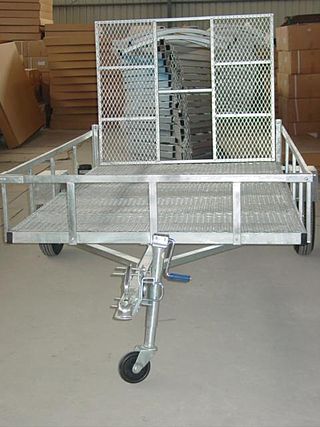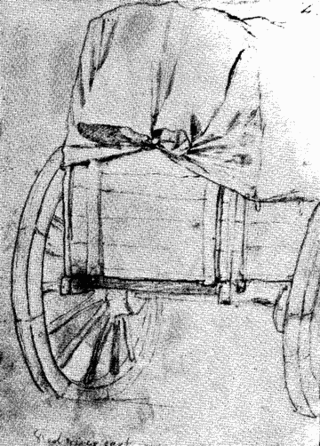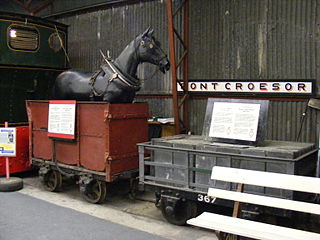Related Research Articles

The Rainhill trials were a competition run from the 6 to 14 October 1829, to test George Stephenson's argument that locomotives would have the best motive power for the then nearly-completed Liverpool and Manchester Railway (L&MR). Ten locomotives were entered, of which five were able to compete, running along a 1 mile (1.6 km) length of level track at Rainhill, in Lancashire.

The Black Country Living Museum is an open-air museum of rebuilt historic buildings in Dudley, West Midlands, England. It is located in the centre of the Black Country, 10 miles west of Birmingham. The museum occupies 10.5 hectares of former industrial land partly reclaimed from a former railway goods yard, disused lime kilns, canal arm and former coal pits.

A wagon is a heavy four-wheeled vehicle pulled by draft animals or on occasion by humans, used for transporting goods, commodities, agricultural materials, supplies and sometimes people.

Brownhills is a historic market and industrial town in the Metropolitan Borough of Walsall of the West Midlands, England. The town is located south of Cannock Chase and close to the large Chasewater reservoir, it is 6 miles (9.7 km) northeast of Walsall, a similar distance southwest of Lichfield and 13 miles (20.9 km) miles north-northwest of Birmingham. It is part of the Aldridge-Brownhills parliamentary constituency and neighbours the villages of Pelsall and Walsall Wood. It lies within the boundaries of the historic county of Staffordshire.

A dragline excavator is a heavy-duty excavator used in civil engineering and surface mining. It was invented in 1904, and presented an immediate challenge to the steam shovel and its diesel and electric powered descendant, the power shovel. Much more efficient than even the largest of the latter, it enjoyed a heyday in extreme size for most of the 20th century, first becoming challenged by more efficient rotary excavators in the 1950s, then superseded by them on the upper end from the 1970s on.

Tandem, or in tandem, is an arrangement in which two or more animals, machines, or people are lined up one behind another, all facing in the same direction. Tandem can also be used more generally to refer to any group of persons or objects working together, not necessarily in line.

A trailer is an unpowered vehicle towed by a powered vehicle. It is commonly used for the transport of goods and materials.There are two general categories of trailers: the full trailer and the semitrailer. A full trailer is a type of trailer whose entire weight is supported by its own wheels, with no weight transferred to the towing vehicle. In contrast, a semi-trailer is designed so that a portion of its weight is carried by its own wheels, while the remaining weight is borne by the towing vehicle.

A dump truck, known also as a dumping truck, dump trailer, dumper trailer, dump lorry or dumper lorry or a dumper for short, is used for transporting materials for construction as well as coal. A typical dump truck is equipped with an open-box bed, which is hinged at the rear and equipped with hydraulic rams to lift the front, allowing the material in the bed to be deposited ("dumped") on the ground behind the truck at the site of delivery. In the UK, Australia, South Africa and India the term applies to off-road construction plants only and the road vehicle is known as a tip lorry, tipper lorry, tipper truck, tip truck, tip trailer or tipper trailer or simply a tipper.

A Thames sailing barge is a type of commercial sailing boat once common on the River Thames in London. The flat-bottomed barges, with a shallow draught and leeboards, were perfectly adapted to the Thames Estuary, with its shallow waters and narrow tributary rivers. The larger barges were seaworthy vessels, and were the largest sailing vessel to be handled by just two men. The average size was about 120 tons and they carried 4,200 square feet (390 m2) of canvas sail in six working sails. The mainsail was loose-footed and set up with a sprit, and was brailed to the mast when not needed. It is sheeted to a horse, as is the foresail; they require no attention when tacking. The foresail is often held back by the mate to help the vessel come about more swiftly.

The Red River cart is a large two-wheeled cart made entirely of non-metallic materials. Often drawn by oxen, though also by horses or mules, these carts were used throughout most of the 19th century in the fur trade and in westward expansion in Canada and the United States, in the area of the Red River and on the plains west of the Red River Colony. The cart is a simple conveyance developed by Métis for use in their settlement on the Red River in what later became Manitoba. With carts, the Metis were not restricted to river travel to hunt bison. The Red River cart was largely responsible for commercializing the buffalo hunt.

Netherton is a town of the Metropolitan Borough of Dudley, 2 miles (3 km) south of Dudley in the West Midlands of England. It was historically part of Worcestershire. The town is part of the Black Country, Netherton is bounded by nature reserves to the east and west, and an industrial area and the Dudley Southern By-Pass to the north.

A horse-drawn vehicle is a piece of equipment pulled by one or more horses. These vehicles typically have two or four wheels and were used to carry passengers or a load. They were once common worldwide, but they have mostly been replaced by automobiles and other forms of self-propelled transport but are still in use today.

A steelyard balance, steelyard, or stilyard is a straight-beam balance with arms of unequal length. It incorporates a counterweight which slides along the longer arm to counterbalance the load and indicate its weight. A steelyard is also known as a Roman steelyard or Roman balance.

The dandy waggon is a type of railway carriage used to carry horses on gravity trains. They are particularly associated with the narrow gauge Festiniog Railway (FR) in Wales where they were used between 1836 and 1863.

A horse harness is a device that connects a horse to a horse-drawn vehicle or another type of load to pull. There are two main designs of horse harness: (1) the breast collar or breaststrap, and (2) the full collar or collar-and-hames.

The Merthyr Tramroad was a 9.75-mile-long (15.69 km) line that opened in 1802, connecting the private lines belonging to the Dowlais and Penydarren Ironworks with the Glamorganshire Canal at Abercynon, also serving the Plymouth Ironworks along the way. It is famous as the line, on which Richard Trevithick's experimental locomotive hauled the first train to carry a load. It was largely superseded when the Taff Vale Railway opened in 1841, and sections gradually went out of use over two decades, from about 1851.
The load, also known as a fodder, fother, and charrus, is a historic English unit of weight or mass of various amounts, depending on the era, the substance being measured, and where it was being measured. The term was in use by the 13th century, and disappeared with legislation from the 1820s onwards. Modern equivalents of historical weights and measures are often very difficult to determine, and figures given here should be treated with caution.

A truss is a tight bundle of hay or straw. It would usually be cuboid, for storage or shipping, and would either be harvested into such bundles or cut from a large rick.
N. Hingley & Sons Ltd was a firm that originated in the Black Country region of England. It was founded by Noah Hingley (1796–1877) who started making chain near the village of Cradley. The firm moved to Netherton around 1852, where large scale chain and anchor manufacturing works were set up on the Dudley No.2 canal. One of the most famous products of the firm was the anchor of the RMS Titanic which on completion in 1911 was drawn through the streets of Netherton on a wagon drawn by 20 shire horses.
Noah Hingley (1796–1877) was an English industrialist from the Black Country region of the United Kingdom. He started making chain near the village of Cradley. He founded the firm N. Hingley & Sons in 1838 which became a large scale manufacturer of anchors and chains with large works on the Dudley No. 2 Canal at Netherton. He became Mayor of Dudley in 1869 and stood unsuccessfully for parliament in 1874.
References
- 1 2 3 "Carters Yard" (PDF). Fact Sheet. Black Country Living Museum . Retrieved 3 May 2013.
- 1 2 "The Carters Yard". Interactive Map. Black Country Living Museum . Retrieved 3 May 2012.
- ↑ Rowlands, [by] Marie B. (1975). Masters and men : in the West Midland Metalware trades before the industrial revolution . Manchester: Manchester University Press. ISBN 0719005825.
- ↑ Smith, Jonathan (11 September 2012). "Titanic: The Hingley Anchors". Encyclopedia Titanica.